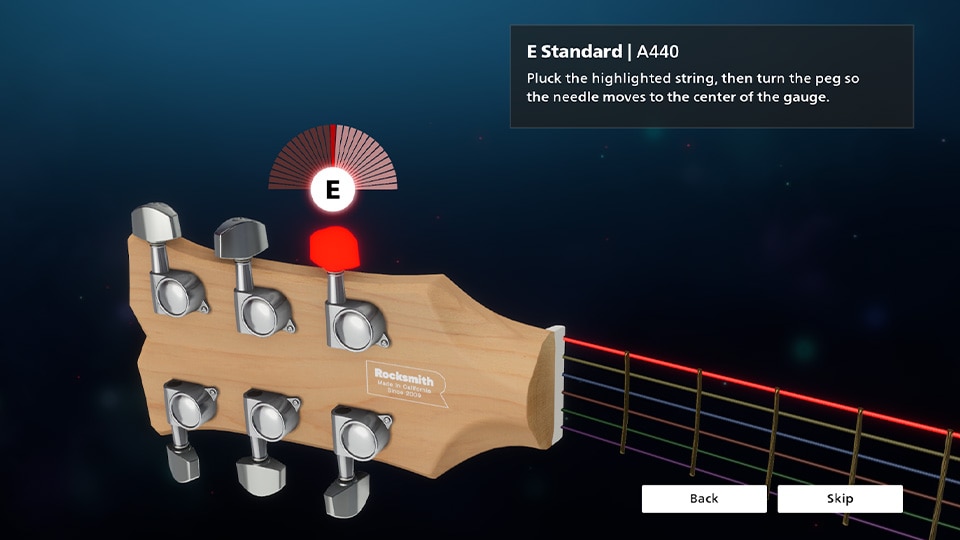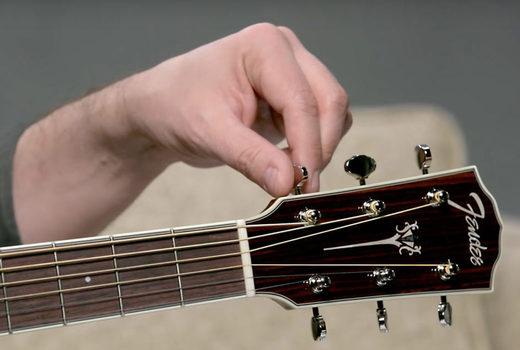Have you ever strummed your guitar and thought, “Hmm, this doesn’t sound quite right”? Fear not, fellow tips-to-get-back-on-track/” title=”Why is Guitar so Frustrating? 5 Tips to get Back on Track”>musicians, for we have the key tips to help you master the art of guitar tuning! From tuning forks to digital tuners, we’ll show you how to achieve pitch perfection faster than you can say “EADGBE”. So grab your guitar and get ready to rock out with your strings out!
Contents
- 1 Understanding the Basics of Guitar Tuning
- 2 Exploring Different Types of Guitar Tuners
- 3 The Significance of Standard Tuning and Alternate Tunings
- 4 Step-by-Step Guide to Tuning Your Guitar by Ear
- 5 Advanced Techniques for Fine-Tuning Your Instrument
- 6 Maintaining Your Guitar to Stay in Tune Longer
- 7 Common Tuning Mistakes and How to Avoid Them
- 8 FAQs
- 9 Rock On and Tune Up!
Understanding the Basics of Guitar Tuning
So you’ve finally decided to pick up that dusty old guitar in the corner and give it a whirl. But wait! Before you start strumming away like a rockstar, you’ve got to make sure that bad boy is in tune. And no, that doesn’t mean twisting the knobs randomly until it sounds somewhat decent. Let’s break down the basics of guitar tuning for you.
First off, you need to know the standard tuning for a guitar. It goes like this: EADGBE. No, that’s not some secret code – it’s the order of the strings from thickest to thinnest. You can remember it with this handy mnemonic: Elephants And Donkeys Grow Big Ears.
Now, how do you actually tune those strings? Well, you could use an electronic tuner, but where’s the fun in that? Real guitar heroes use their ears. Grab a tuning fork or use an online tuner to get your low E string in tune, then use the fifth fret method to tune the rest of the strings. It’s like a musical game of telephone – but with fewer awkward conversations.
Remember, tuning your guitar is like setting the foundation for a beautiful musical masterpiece. So don’t rush through it – take your time and enjoy the process. And if all else fails, just pretend you’re going for that edgy, avant-garde sound. Who needs perfect pitch anyway?

Exploring Different Types of Guitar Tuners
When it comes to tuning your guitar, there are a plethora of options to choose from. From traditional clip-on tuners to high-tech smartphone apps, the world of guitar tuning is vast and varied. Let’s dive into some of the different types of guitar tuners out there:
- Clip-on Tuners: These little gadgets attach to the headstock of your guitar and use vibrations to determine the pitch of each string. They’re small, portable, and great for tuning on the go.
- Pedal Tuners: For the guitarist who likes to keep things organized, pedal tuners are a great option. These tuners sit on your pedalboard and allow you to quickly tune up between songs during a gig.
- Smartphone Apps: In this digital age, there’s an app for everything – including tuning your guitar. Simply download a tuner app to your phone, play a string, and watch as the app tells you if you’re sharp or flat.
- Rackmount Tuners: If you’re a serious musician with a full rack of gear, a rackmount tuner might be the way to go. These tuners sit in your rack and provide accurate tuning capabilities without taking up extra space.

The Significance of Standard Tuning and Alternate Tunings
So, you think you’re a guitar aficionado, huh? Well, let’s talk about , shall we?
First off, let’s give some props to good ol’ standard tuning – EADGBE. It’s like the white bread of guitar tunings – it’s reliable, it’s versatile, and it’s just what you need when you want to play your favorite tunes without any fuss. But hey, where’s the fun in that? Enter alternate tunings – the spice of life for guitarists. From Open D to Drop C, there’s a whole world of funky tunings out there just waiting for you to explore.
Why stick to one boring tuning when you can mix things up and explore new sounds and possibilities? Alternate tunings can inspire creativity, push you out of your comfort zone, and make you look like a guitar god (or goddess) in front of your friends. Plus, it’s a great way to challenge yourself and keep things interesting.
Whether you’re strumming away in standard tuning or experimenting with alternate tunings, the key is to have fun and enjoy the ride. So next time you pick up your guitar, why not give alternate tunings a shot? Who knows, you might just discover a whole new world of musical awesomeness.

Step-by-Step Guide to Tuning Your Guitar by Ear
So you’ve decided to take the plunge and tune your guitar by ear, eh? Well, get ready for a wild ride filled with twists, turns, and questionable musical decisions. But fear not, dear reader, for we are here to guide you through this treacherous journey with our step-by-step guide.
First things first, grab your trusty guitar and let’s get started. Start by plucking the low E string and comparing it to a reference pitch, either from a tuning app or a pitch pipe. Use your finely-tuned ears to adjust the tuning peg until the pitches match. Remember, close enough is good enough…sometimes.
Next up, move on to the A string and repeat the process. Get ready to frustrate your roommates, neighbors, and pets with your less-than-perfect tuning skills. Embrace the chaos and revel in the off-key beauty you are creating.
Continue this process for the D, G, B, and high E strings, making sure to take frequent breaks to question your life choices and contemplate whether it’s really worth the effort. Spoiler alert: it probably isn’t, but hey, at least you can say you did it the old-fashioned way. Good luck, brave soul!

Advanced Techniques for Fine-Tuning Your Instrument
So you’ve mastered the basics of playing your instrument and now you’re ready to take it to the next level! Here are some advanced techniques to help fine-tune your skills:
1. Experiment with alternate tunings: Instead of sticking to the standard tuning, why not try experimenting with different tunings to discover new sounds and expand your musical horizons?
2. Focus on dynamics: Don’t just play each note at the same volume – experiment with playing louder and softer to add depth and emotion to your music.
3. Work on your vibrato: Adding vibrato to your notes can really make them come alive. Practice varying the speed and intensity of your vibrato to find your own unique style.
4. Explore different techniques: Whether it’s mastering sweep picking on the guitar or perfecting double tonguing on the trumpet, learning new techniques can help you stand out as a musician and keep things interesting.
Maintaining Your Guitar to Stay in Tune Longer
Let’s face it, there’s nothing worse than picking up your guitar to strum a few chords only to find out it’s completely out of tune. Don’t worry, I’ve got some tips to help you keep your guitar in tune longer so you can avoid those dreaded tuning sessions.
First things first, make sure to clean your guitar regularly. Dust and grime can build up on your strings and tuning pegs, causing them to slip out of tune more easily. Use a soft cloth to wipe down your guitar after each practice session to keep it looking and sounding its best.
Next, be sure to stretch your strings properly when restringing your guitar. This will help them settle into place and stay in tune longer. Gently pull on each string after you’ve tuned it up to give it a good stretch before snipping off the excess length.
Lastly, invest in a good quality tuner. Tuning by ear is all well and good, but a tuner will ensure your guitar is perfectly in tune every time. Plus, it saves you from having to listen to someone tell you that you’re playing in “that weird off-key again.” Trust me, it’s worth it.
Common Tuning Mistakes and How to Avoid Them
One common tuning mistake is over-tightening your strings. This can lead to broken strings and a whole lot of frustration. Remember, tuning should be a delicate process, not a wrestling match with your instrument! So, take it easy and tighten those strings gradually.
Another mistake to avoid is not using a tuner. Sure, tuning by ear might sound cool in theory, but in reality, it often results in a cacophony of off-key notes. Save yourself the headache and invest in a good tuner. Your audience will thank you!
Lastly, a common mistake is neglecting to stretch your strings after tuning. Your strings need to settle into their new tuning, just like a pair of new shoes need to be broken in. So, give them a gentle pull to help them adjust. Your guitar will sound much better for it!
FAQs
Why is tuning your guitar so important?
Well, imagine trying to cook a gourmet meal with all the ingredients mixed up - it just wouldn’t taste the same. The same goes for playing guitar; if your strings are out of tune, your music will sound like a cacophony of cats fighting in a junkyard.
What are some common methods for tuning a guitar?
There’s the classic method of using a tuner, which is like having a personal musical assistant. Or you can go old school and tune by ear, but be prepared to sound like a bag of cats trying to mimic a Jimi Hendrix solo.
How often should I tune my guitar?
As often as you change your socks – if you want to sound like a rockstar, that is. A daily tune-up will keep your guitar sounding sweet and prevent any embarrassing off-key moments during your next jam session.
What should I do if my guitar won’t stay in tune?
First, check for any loose hardware or worn-out strings – your guitar might just be throwing a temperamental fit. If all else fails, maybe it’s time for a heart-to-heart with your instrument and some TLC.
Any tips for mastering tuning for beginners?
Practice, practice, practice – and maybe invest in a good tuner to save yourself from sounding like a garage band at open mic night. Remember, even the pros started out with sour notes and screechy strings.
Rock On and Tune Up!
Congratulations, you’ve now unlocked the secrets to mastering guitar tuning like a pro! Remember, tuning your guitar is the key to sounding great and rocking out with confidence. So grab your instrument, channel your inner rockstar, and start strumming those perfectly tuned chords. Keep practicing, stay in tune, and most importantly, have fun shredding like there’s no tomorrow. Rock on!



